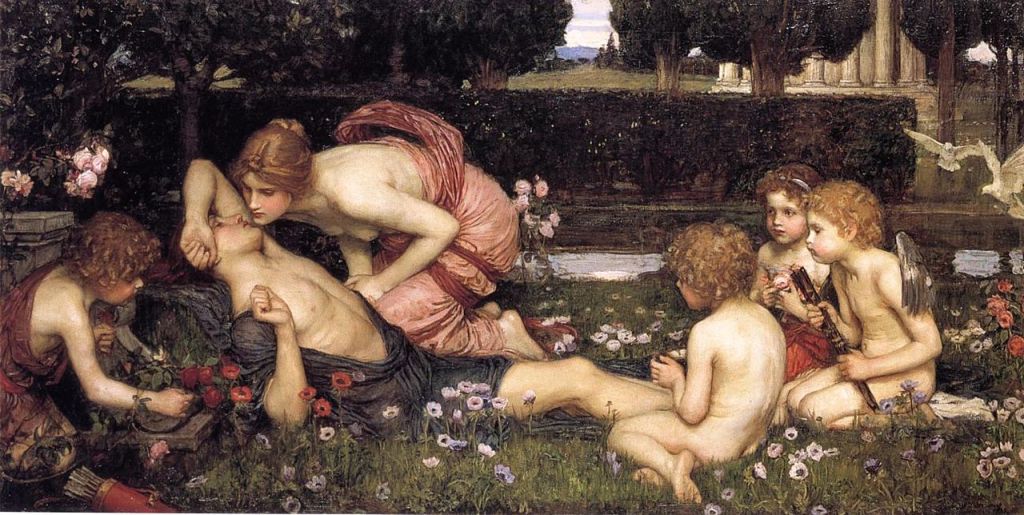Adonis is borne in Greek mythology by the god of beauty and desire. According to the most popular myth, he was born of the incestuous union of Theias and his daughter Myrrha. Myrrha had tricked her own father into having sex with her. The gods transformed Myrrha into a myrrh tree after Theias attempted to kill her whilst pregnant with Adonis. Adonis was beloved of Aphrodite and mothered by Persephone, but he was subsequently killed by a boar when Artemis, or in some versions, Ares, sent a boar to kill Adonis out of jealousy. When Adonis died, Aphrodite cried tears which mingled with Adonis’ blood, producing the Anemone flower. Aphrodite instituted the Adonia festival in his commemoration, whereby all women had a mass mock funeral of Adonis by growing plants in potsherds on their rooftops and performing a mass funeral ritual as soon as the plants sprouted.
It is likely Adonis was imported by the Greeks from the Phoenicians, the latter being the descendants of the Sumerians, Mesopotamians & Babylonians. It is believed by most scholars that Adonis is an adaptation of the Sumerian story of Dumuzid & Inanna (later Tammuz & Ishtar), in which a ritual funeral rite was also performed by women across the former Babylonian empire. Adonis itself is a Hellenized form of the Canaanite, adon, which means “lord” and was often used as an appellation by the Canaanites for the god Tammuz. The Jews adopted this appellation for Yahweh in the form of Adonai (my lord).
Adonis is borne by an 8th-century French saint of Vienne. He is also listed as Adon & Ado. Adonis has sporadically been used as a given-name in Greece, anglophone, francophone & hispanophone countries. The French feminine off-shoots, though rare these days, are Adonise (AH-do-NEEZ) and Adonie, and were actually prevalent in 18th-centurry Quebec & New Orleans. An obscure Italian feminine form is Adonella.
There is the male Biblical Hebrew name, Adonijah meaning (my lord is Yahweh). It is borne by a son of King David and was Hellenized in the Septuagint as Adonias.
Other forms include:
- Adonies (Catalan)
- Adonia (Dutch, Italian, Swedish)
- Adonija Адония (French, German, Russian)
- Adonias Αδωνίας (French, Greek, Portuguese)
- Adonías (Galician)
- Adonja (Norwegian)
- Adoniasz (Polish)
- Adonías (Spanish)
- Adoniya Адонія (Ukrainian)
Currently, Adonis is the 242nd most popular male name in the United States and the 461st most popular in France.
Other forms include:
- Adonisi ადონისი (Albanian, Georgian)
- Adonis Адонис Адоніс Άδωνις Ադոնիս (Armenian, Bosnian, Bulgarian, Croatian, Dutch, English, Estonian, French, Macedonian, German, Greek, Polish, Romanian, Russian, Ukrainian, Scandinavian, Serbian, Slovene, Spanish, Turkish)
- Adónis Адо́ніс (Belarusian, Continental-Portuguese, Czech, Slovak)
- Adó (Catalan)
- Adónisz (Hungarian)
- Adone, Adon (Italian)
- Adônis (Brazilian-Portuguese)
- Adón (Spanish)
Sources

 Gender: Feminine
Gender: Feminine